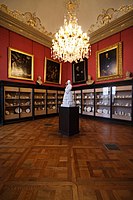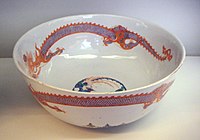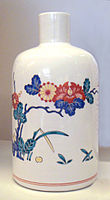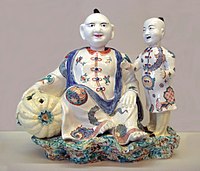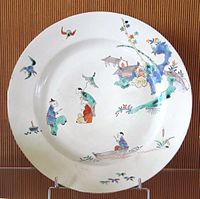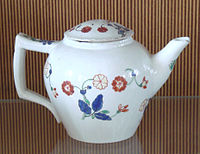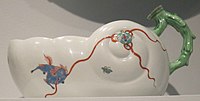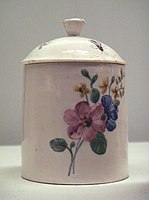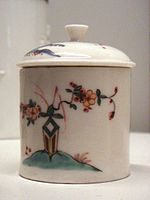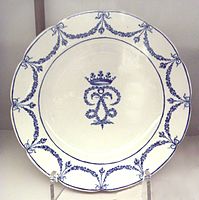Chantilly porcelain

| French porcelain |
|---|
 |
|
Chantilly porcelain is French soft-paste porcelain produced between 1730 and 1800 by the manufactory of Chantilly in Oise, France. The wares are usually divided into three periods, 1730–1751, 1751–1760, and a gradual decline from 1760 to 1800.
The factory made table and tea wares, small vases, and some figures, these all of Orientals.
Foundation
Outbuildings were purchased in March 1730 on the banks of the small
Like the other French factories of this period, and unlike the "Saxon"
First period: Chinese and Japanese designs (1725-1751)
Condé was an avid collector of East Asian porcelains, both Chinese and Japanese, and his Chantilly manufactory's first decade of output showed the marked influence of
Decorative
A patent granted to the factory in 1735 by
At first the body of the ware was covered with an opaque
The prince de Condé died in 1740, after which the factory was forced to support itself, and reduced its ambitions.
-
The Salon des porcelaines, Château de Chantilly.
-
Chantilly soft-porcelain terrine, Japanese Kakiemon style, 1725–1751.
-
Chantilly soft-paste porcelain bowl, with Chinese dragon, 1725–1751.
-
Chantilly soft-paste porcelain seau, or wine bucket, 1725–1751.
-
Chantilly soft-paste porcelain bottle in the Japanese Kakiemon style, 1730–1735.
-
Chantilly soft-paste porcelain teapot, with Chinese dragon, 1735–1740.
-
Chantilly soft-paste porcelain Magots, 1740.
-
Chantilly porcelain plate, Kakiemon style, 1725–1751.
-
Chantilly porcelain sugar bowl, Kakiemon style, 1725–1751.
-
Chantilly milk pot in Kakiemon style, 1725–1751.
-
Chantilly pharmacological jar, with Kakiemon designs, 1725–1751.
-
Chantilly soft-paste porcelain plate with Japanese Kakiemon design, 1725–1751.
-
French bourdaloue, Chantilly, soft-paste porcelain, c. 1735.
Intermediate period (1751–1760)
Potters from Chantilly were induced to move to Vincennes, initiating the porcelain manufacture that would receive royal patronage at Sèvres and absorb the French market for porcelain of the highest refinement; letters patent of 1752 granting a monopoly to Vincennes of polychrome decors further reduced Chantilly's scope.[12]
-
Chantilly soft-paste porcelain, 1750–1760.
-
Chantilly soft-paste porcelain, 1750–1760.
-
Chantilly soft-paste porcelain, 1750–1760.
-
Figure seated on a lion, Chantilly Porcelain Factory, about 1750.
-
Chantilly soft-porcelain plate, circa 1760.
Late period (1760–1800)

The factory at Chantilly produced some wares in the Vincennes-Sèvres taste but, especially after its sale in 1781 by Dame Adam, was in rapid decline towards the end of the
See also
References
- ^ Geneviève Le Duc, Porcelaine tendre de Chantilly au XVIIIe siècle, Paris, 1996, the first full-length monograph.
- ^ Its precursor was the porcelain manufacture of Rouen: see M.L. Solon, "The Rouen Porcelain", The Burlington Magazine for Connoisseurs 7 (May 1905:116-124).
- ^ Metropolitan Museum of Art: "French porcelain in the eighteenth century"; W.B. Honey, French Porcelain of the 18th Century, London, 1950.
- ^ Metropolitan Museum of Art, acc. no. 50.211.121: A large Chantilly jar, ca 1735–40 copies a Japanese form and Kakiemon coloring; Cleveland Museum of Art: Tea set, ca.1730, acc. no. 1944.228[permanent dead link]
- ^ Such as Cleveland Museum of Art: Seated Chinese with a Pot, ca.1740, acc. no. 1947.62[permanent dead link].
- ^ John Fleming and Hugh Honour, Dictionary of the Decorative Arts, 1977 s.v. "Chantilly porcelain factory".
- ^ William Chaffers, Marks and monograms on pottery & porcelain s.v. "Chantilly".
- ^ Cirou had probably gained his expertise at Saint-Cloud; where he was a painter; in 1728 he was working in rue de la Ville l'Evêque (The Grove Encyclopedia of Decorative Arts, s.v. "Chantilly: Porcelain").
- ^ E.g. Hodder Michael Westropp, Handbook of pottery and porcelain, 1880; Old and Sold: "Chantilly China 1725-1789" etc.
- ^ J. Paul Getty Museum: "Chantilly Porcelain Manufactory"
- ^ Reproduction of a Chantilly teapot, Edme Samson et Cie., Paris, ca 1900
- ^ The Grove encyclopedia of decorative arts by Gordon Campbell, p.223
- ^ Potter's purchase marks the end of the period covered by Le Duc 1996.
- ^ <Valfré Patrice, « Christopher Potter, le potier révolutionnaire, et ses manufactures de Paris, Chantilly, Montereau », Bagneaux sur Loing, 2012, pp. 199–201

